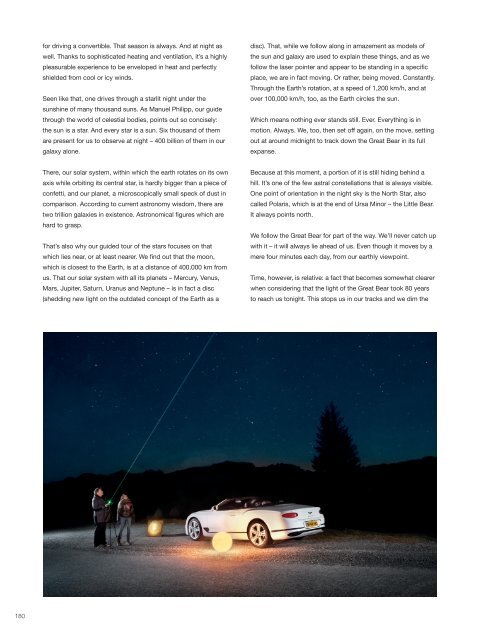Diplomatic World 67
You also want an ePaper? Increase the reach of your titles
YUMPU automatically turns print PDFs into web optimized ePapers that Google loves.
for driving a convertible. That season is always. And at night as<br />
well. Thanks to sophisticated heating and ventilation, it’s a highly<br />
pleasurable experience to be enveloped in heat and perfectly<br />
shielded from cool or icy winds.<br />
Seen like that, one drives through a starlit night under the<br />
sunshine of many thousand suns. As Manuel Philipp, our guide<br />
through the world of celestial bodies, points out so concisely:<br />
the sun is a star. And every star is a sun. Six thousand of them<br />
are present for us to observe at night – 400 billion of them in our<br />
galaxy alone.<br />
disc). That, while we follow along in amazement as models of<br />
the sun and galaxy are used to explain these things, and as we<br />
follow the laser pointer and appear to be standing in a specific<br />
place, we are in fact moving. Or rather, being moved. Constantly.<br />
Through the Earth’s rotation, at a speed of 1,200 km/h, and at<br />
over 100,000 km/h, too, as the Earth circles the sun.<br />
Which means nothing ever stands still. Ever. Everything is in<br />
motion. Always. We, too, then set off again, on the move, setting<br />
out at around midnight to track down the Great Bear in its full<br />
expanse.<br />
There, our solar system, within which the earth rotates on its own<br />
axis while orbiting its central star, is hardly bigger than a piece of<br />
confetti, and our planet, a microscopically small speck of dust in<br />
comparison. According to current astronomy wisdom, there are<br />
two trillion galaxies in existence. Astronomical figures which are<br />
hard to grasp.<br />
That’s also why our guided tour of the stars focuses on that<br />
which lies near, or at least nearer. We find out that the moon,<br />
which is closest to the Earth, is at a distance of 400,000 km from<br />
us. That our solar system with all its planets – Mercury, Venus,<br />
Mars, Jupiter, Saturn, Uranus and Neptune – is in fact a disc<br />
(shedding new light on the outdated concept of the Earth as a<br />
Because at this moment, a portion of it is still hiding behind a<br />
hill. It’s one of the few astral constellations that is always visible.<br />
One point of orientation in the night sky is the North Star, also<br />
called Polaris, which is at the end of Ursa Minor – the Little Bear.<br />
It always points north.<br />
We follow the Great Bear for part of the way. We’ll never catch up<br />
with it – it will always lie ahead of us. Even though it moves by a<br />
mere four minutes each day, from our earthly viewpoint.<br />
Time, however, is relative: a fact that becomes somewhat clearer<br />
when considering that the light of the Great Bear took 80 years<br />
to reach us tonight. This stops us in our tracks and we dim the<br />
headlights of the Continental to parking lights, so as not to disturb<br />
this light from the stars.<br />
Our growing humility in the face of this seemingly endless shining<br />
world above our heads becomes deeper still with Manuel<br />
Philipp’s final statement, “This Bentley is made of stardust”.<br />
Add incredulity to amazement and humility. It seems an all too<br />
far-fetched comparison. And yet, the astronomer and physicist<br />
argues that everything on planet Earth – all material – comes<br />
mainly from the “belly” of a giant star.<br />
everything that we’ve brought forth comes from one and the<br />
same place. This lends far deeper meaning to the surname of<br />
David Bowie’s alter ego, Ziggy Stardust.<br />
So our origins are written in the stars. Just like our present. And<br />
even more so, the future. At Bentley, our future will take shape<br />
under an electric star. When we return to the Star Park next year<br />
for a night-time visit, our companion will be able to glide through<br />
the alpine pastures in electric mode. And soon thereafter, as an<br />
all-electric vehicle.<br />
According to current knowledge, this giant star exploded in the<br />
context of a supernova at some point in the distant past. The<br />
stardust it generated was carried into a nearby cloud of gas. It<br />
was from this stardust-enriched cosmic cloud that, several hundred<br />
million years later, our solar system developed with the sun<br />
as its central star and orbited by eight planets.<br />
Photos: Bentley<br />
Thus, everything in and around us is pure stardust, matter that<br />
was created from the nuclear fusion that occurred inside that<br />
giant star. And without whose existence we would not exist –<br />
because the ball of rock we now call Earth wouldn’t have<br />
emerged from thunder and lightning. On the Earth nearly<br />
180 181

















